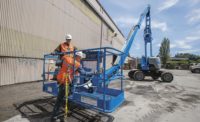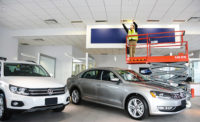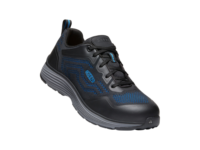Working at height is a part of many jobs. Whether you’re an owner, supervisor or laborer, if the job calls for working at heights of 8, 20, 50 feet or more, you need to consider how best to access those heights safely. Powered access equipment is most often the safest and most productive method of reaching overhead areas and the International Powered Access Federation is a worldwide organization that promotes the safe and effective use of powered access equipment in the widest sense—through providing technical advice and information, influencing and interpreting legislation and standards, and through its safety initiatives and training programs.
IPAF is a not-for-profit organization owned by its members who include manufacturers, rental and training companies, dealers, contractors, users, and operators throughout the world. The diversity of membership allows IPAF to have the insight and voice for all stakeholders. The organization’s primary goal is to promote the safe and effective use of aerial work platforms and mast climbing work platforms through education in the proper and safe use of the equipment.
THE FEDERATION’S BIRTH
IPAF was formed in 1983 and will celebrate its 30th anniversary this year. Some may not consider 30 years a long time but it is a lifetime in the powered access industry. It was only in the 1970s that aerial work platforms began to emerge as a viable option for access to temporary work at height and a viable alternative to ladders and scaffolds. IPAF was born in the United Kingdom where local industry leaders formed the organization to provide a unified approach to safe use and promotion of powered access equipment.
Since then, the aerial work platform industry has grown rapidly, and, as with any new industry, regulations lagged the growth. In 1970, when OSHA was first signed into law, the only ANSI regulation in place at the time that covered the use of access equipment was ANSI A92.2-1969 for Vehicle Mounted Elevating and Rotating Work Platforms. That standard was adopted into the OSHA regulations and remains the only ANSI A92 standard adopted by OSHA to this day. While ANSI standards must be reviewed every 5 years, OSHA regulations have no requirements and lag equipment changes in the market. Today, most countries have developed their own regulations and standards, many using the original ANSI standards as a foundation.
While the manufacturers and users of the equipment are the same regardless of where you are on the planet, there are always differences between the regulations and standards. To help maintain commonality in standards, IPAF has provided a unified voice for the industry as new standards are developed and others are reviewed. With representation in many countries, IPAF has attempted to harmonize the many worldwide standards and use common terminology and safe use practices. IPAF has a Manufacturer’s Technical Committee that constantly reviews the activities of standards being developed around the world with many IPAF representatives sitting on national regulatory councils.
WORLDWIDE REACH
IPAF has offices in the United States, France, Germany, Holland, Italy, Spain, Switzerland, Singapore, Portugal, Chile and administrative headquarters in the United Kingdom. This provides IPAF with the unique ability to address issues in individual countries as well as internationally. IPAF takes a proactive stance on industry issues, concerns and opportunities through local, regional, national and international expos, seminars, and meetings. Ongoing efforts have been influential in many established design, safety and testing procedures and in creating and implementing changes that impact the industry worldwide.
IPAF staff and volunteers possess hundreds of years of industry experience and knowledge. These qualified individuals provide technical advice and guidance on all aspects of the industry. Topics that are common issues are addressed with technical guidance notes regarding issues such as fall protection with AWPs, or training and familiarization. Other, more in-depth educational documents such as “The Statement of Best Practices of General Training and Familiarization for Aerial Work Platform Equipment,” “The Statement of Best Practices for Workplace Risk Assessment and Aerial Work Platform Equipment Selection,” and “The Statement of Best Practices of Personal Fall Protection Systems for Aerial Work Platform Equipment” are first-of-their-kind industry initiatives designed to clarify what is required when using aerial work platform equipment.
These “Best Practice Guides” are based on applicable ANSI and OSHA standards and were developed for use in the U.S. in conjunction with the American Rental Association, the Association of Equipment Manufacturers, the Associated Equipment Distributors, the International Powered Access Federation and the Scaffold Industry Association.
IPAF has also developed numerous international safety campaigns, such as “Click-it,” to remind occupants of boom-type AWPs to wear required personal fall protection and “Spread the Load” to raise awareness regarding adequate ground support for AWPs. In addition to literature and stickers placed on the equipment, IPAF has also created several videos on each of these topics to raise awareness and educate users of this equipment. These videos are also available free of charge downloads from their web site.
One of the unique member-only benefits offered by IPAF is the operator training program. This program is delivered by members who are approved Training Centers and audited by IPAF for compliance. IPAF maintains oversight and issues picture ID cards (called PAL Cards) to successful trainees. IPAF has close to 600 training centers worldwide and about 30 in North America. IPAF issues more than 100,000 PAL cards annually.
The operator training program is reviewed and updated annually and is part of a continuous improvement scheme. In 2013 IPAF will be introducing a new eLearning module into the program. This option, available through IPAF members who chose to become approved training centers, will provide more flexibility and availability of the operator training course.
Since IPAF’s 2007 full time introduction into the North American market with the establishment of American Work Platform Training, it has made significant progress in its recognition as an influential voice for the aerial and mast climbing industry. In addition to the safety awareness campaigns and best practice documents mentioned earlier, IPAF members have a voice on the ANSI A92 and A10 committees, ISO U.S. technical advisory group, and the Canadian Standards Association.
IPAF North America has its own council to address the specific issues of the North American market and an annual US convention that offers networking, safety promotion and insight from industry leaders. In March, IPAF held its annual Summit and International Awards for Powered Access in Miami, Fla., the first time the event has been held outside of Europe. More than 350 delegates from around the world attended the successful event.
For more information, visit www.ipaf.org or www.awpt.org.
Much of this information is offered free of charge and is downloadable from the “Publications” sections OF www.ipaf.org and www.awpt.org








Report Abusive Comment